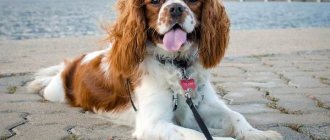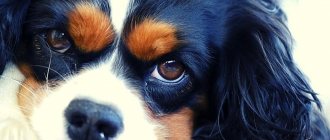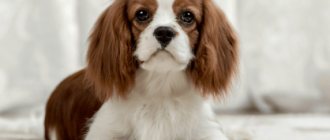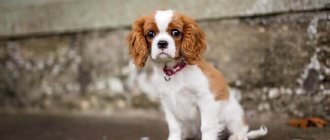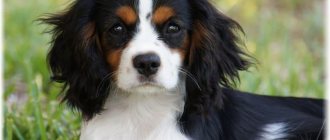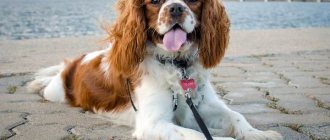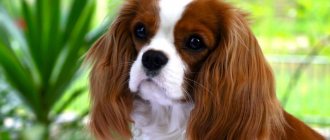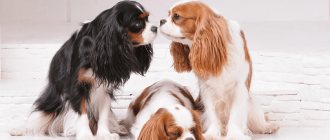Each breed of dog has a predisposition to certain diseases. We have collected information about typical diseases of the breed. Remember the symptoms of the disease, which every pet is at risk of developing, and then you can help him in a timely manner.
Cavalier King Charles Spaniels are ideal companion dogs that retain the athletic character of their ancestors. They love hiking, running on the beach, and agility, flyball and rallying. Some have even shown their prowess as hunting dogs. The calmer representatives of the breed make ideal family and therapy dogs.
- Country of origin : UK
- Height at withers : up to 32 cm
- Weight : male: 5.9 – 8.2 kg, female: 5.9 – 8.2 kg
- Lifespan : 9-14 years
- Use : companion dog
Description of the Cavalier King Charles Spaniel breed
Popularity 217th place among 263 dog breeds
Lifespan:
11-12 years old
Breed group:
Decorative
Height:
up to 32 cm
Country of origin:
Great Britain
Average price:
15-30 thousand rubles
Weight:
from 5.5 to 8 kg
Latest articles Cat health
Rabies vaccination for cats: choice of vaccine, necessity, schedule 01/22/2022 20 0 0
Selection and adaptation
TOP 20 best cat breeds for families with children 01/22/2022 33 0 0
Key facts
The name of the breed is very long, but the breeders did not come up with other names, because spaniels have no use for it. The country of origin of friendly cavaliers (this is the abbreviated name of the breed) is Great Britain.
The characteristics of the Cavalier King Charles Spaniel breed say that these dogs are extroverts to the core. They have an irresistible desire to quickly get acquainted with the giant world around them, to smell and lick everything and everyone. Spaniels love to be stroked and gently brushed with a massage brush; In addition, they love to spend time with their owner, especially in his arms. A dog can achieve such intimacy in all ways known to him, most often through excessive affection. Cute nicknames will easily reflect the pet’s inner world; they will best match the description of the Cavalier King Charles Spaniel breed.
Small sizes allow you to keep gentlemen even in a small apartment. The height at the withers, that is, the height of the Cavalier King Charles Spaniel, reaches 32 cm (females are usually shorter than males). The standard weight is considered to be in the range from 5 to 8 kg (females weigh 5-6 kg, males - 6-8 kg). Non-compliance with the stated data is allowed, provided that the animal looks proportional, but a dog with miniature dimensions is more likely to win at the exhibition.
If your dog is active, eats enough and gets enough attention, this will have a positive effect on his condition. The average lifespan of a Cavalier King Charles Spaniel is 12 years; If the owners take good care of their four-legged friends, King Charles dogs live up to 15 years, which is considered quite a long time.
Characteristics
The hunting and guarding instinct, which is a feature of Charles Spaniels, has now been practically lost. These dogs have become friends and companions, which does not allow them to be used as property protectors.
Their characteristic is intelligence. These are very smart pets with whom even gentle people without leadership qualities easily find contact.
History of the origin of the Cavalier King Charles Spaniel
The breed's ancestors, brave miniature hunters, accompanied the Celtic people starting in the ninth century. For a long time they traveled side by side with people, but, once in England, they settled on the territory of this country. Court people, in particular the Stuart dynasty, left gentlemen at court - they played the role of decorative dogs, which they treated tenderly and reverently because of their great love for them. It was believed that the Cavalier King Charles Spaniel breed was developed by Charles II, but the monarch only encouraged breeding work. Despite this, the breed received his name.
John Churchill, Winston Churchill's ancestor, was also fond of breeding spaniels. For his great services to his homeland, the man received an estate where he could breed dogs. In addition to standard breeding, Churchill tried to introduce diversity into the breed's gene pool. The breeder managed to do this: thanks to his activities, the following types of colors appeared: Blenheim and white-pink.
The fashion for pugs, which arose in the eighteenth century, spread to Cavalier Spaniels and made them a purely decorative breed - all the working qualities of the dogs were dulled. Despite this, they remained popular among the nobility, because they proved to people that they remain faithful to their owner in any situation: during palace coups, the dogs did not abandon their owner, helping him to the end.
Similar dog breeds
Pomeranian Spitz
Shih Tzu
Yorkshire Terrier
Bichon Frize
Appearance of a Cavalier King Charles Spaniel
Videos can show how beautifully the coat shimmers in the morning sun, and pictures and photos of the Cavalier King Charles Spaniel prove that this is a smart and mischievous pet.
General impression
The main thing in assessing the appearance of a Cavalier King Charles Spaniel at an exhibition is the proportionality of the height at the withers and weight, but judges can also pay attention to the compliance of the indicators with the standard. A dog may not be allowed to be bred if it does not meet certain criteria.
Head
The head is quite voluminous, the skull is not convex. The high-set ears are covered with dense hair. The stop is normally expressed. The eyes are round and set wide apart; Characteristic colors range from a mixture of brown and gold to black. The look is conscious and friendly.
The muzzle is cone-shaped, narrowing from the base to a black nose with well-developed nostrils. The developed upper lip covers the lower lip. Scissor bite.
Neck
The neck is of normal length with a slightly convex nape allowing the dog to hold its head proudly.
Torso
The somewhat stretched body has smooth, rounded shapes. The shallow chest is oval, connected by a short loin with a flat back, smoothly sloping croup.
Forelegs
Strength, proportionality of length to the body, parallelism are characteristic of the front paws. The elbow fits tightly to the chest. The rounded metatarsals gather into a ball. Claws and pads are black.
Hind limbs
Standing and looking from behind, you will notice that the spaniel's slender hind legs are parallel, not sloping, and more muscular than the front legs. The knee joint is not everted. The hock joint is normally expressed. The paws are rounded and gather into a ball. Claws and pads are black.
Tail
The tail is not docked, which is why it retains its natural length. It doesn’t matter what emotions the pet is experiencing: the tail is almost always no higher than the line of the back.
Movement
The energy and cheerfulness inherent in the “boys” and “girls” of this breed is noticeable in the animal’s fast, springy gait. The paws are moved parallel to each other.
Wool
The wool is smooth and silky. The hairs are either straight or somewhat wavy.
Color
What colors are typical for the Cavalier King Charles Spaniel?
- Blenheim - rich chestnut color of spots on milky white wool, the crown is “marked” with a white diamond;
- ruby - a rich ruby shade of wool, white spots on which are considered a defect;
- black and tan - blue-black coat with red tan marks above the eyes, on the cheekbones, inside the ears, body, tail;
- tricolor - the “background” of pearly white color is diluted with red and black spots.
Solid colors should not be disturbed by spots, inclusions and impurities of any color.
Size
The Cavalier King Charles Spaniel is quite small in size. The normal weight of a Cavalier King Charles Spaniel varies from 5.4 to 8.2 kg, height - up to 34 cm. Puppies quickly gain weight, because of this it is important to monitor their diet. An adult dog must meet the standard to participate in exhibitions, because often obese animals are not allowed to participate.
Appearance and standard
Graceful Charles Spaniels attract attention in any environment. Despite their miniature size, they are very bright and memorable. Show dogs are not groomed. In adult animals, feathering appears, decorating the tail and paws.
The main appearance features are determined by the standard:
| Part of the body | Characteristic |
| Head | Round, flat between the ears with a conical muzzle, lips without drooping, scissor bite, black nose |
| Eyes | Large and expressive, round, widely set |
| Ears | Covered with wool, long, hanging |
| Frame | Compact with rounded ribs, strong bones, level back, well-developed shoulders, strong, slightly convex loin |
| Neck | Slightly inclined, medium length |
| Tail | Low set, superbly furred, rising to the level of the back |
| Limbs | Direct |
Personality of the Cavalier King Charles Spaniel
Who is the Cavalier King suitable for? The uniqueness of the breed lies in the fact that its representatives feel good in the company of active youth, young families, and retirees. The main thing for charming fluffies is the opportunity to be close to the owner: the dog needs mandatory tactile contact, and without an emotional connection the baby will quickly disappear. Therefore, it is important for those people who have adopted a spaniel to be aware of all the responsibilities they have regarding the psychological comfort of their four-legged friend.
Other well-known facts are the positive character traits of the Cavalier King Charles Spaniel: openness, friendliness, energy, sanguine temperament. The gentleman will play with children (especially snowball fights outside in winter), will easily share the territory entrusted to him (but not the owner with other animals), and will not hesitate to ask a stranger on the street to scratch behind the ear.
Sometimes this behavior can irritate the owner, but the only thing that can be done is to play with the pet so that it releases all its irrepressible energy. Because of this, dog experts advise either active people or large families to own dogs of this breed. The third “option” could be buying another four-legged friend.
At home, the gentleman will get bored very quickly (it doesn’t matter whether the owner lives in an apartment or in a country house). Therefore, a long walk is required. Puppies are much more restless than adults, so some corner should be created for them where they could splash out energy and explore the world around them.
Positive traits of a dog
The list of advantages of the breed is difficult to complete: this breed is considered a successful combination of the advantages of a small size without characteristic problems such as a quarrelsome nature, soreness and uncontrollability:
- Cavaliers have a cheerful disposition, are good-natured, and are very attached to people . This is an ideal companion dog for children and older people, he is always ready to communicate and does not get tired of playing. It is ideal for a gentleman to be in a large family, where there are children of different ages for active games and elderly relatives, because the dog loves to sleep on the owner’s lap.
- A dog’s amiability is also evident in how easily it establishes contact with its relatives and other animals: it gets along well with all the pets in the house, and the saying about a cat and a dog will only be remembered as a joke.
- attractive appearance is an additional plus. The bright contrasting color attracts attention to the animal. Despite the long hair, the breed standard does not require much effort in cutting and grooming. All that is required is to cut off the excess hair between the toes, otherwise it may mat.
- A small dog does not require large expenses for food, does not take up extra space in the apartment, because it is smaller than some cats!
- The love of games and outdoor activities will not allow the owners to stay at home. Owners appreciate the intelligence of gentlemen. Unlike most small and stupid breeds, these spaniels are perfectly trainable and have an excellent memory. They learn more slowly than shepherd dogs or huskies, but they learn what they have learned quite quickly and reliably.
- The breed is perfect for novice owners . Even an accommodating grandmother can raise a smart dog that does not strive to become a leader. Unpretentious maintenance and a simple diet will not cause any difficulties. They just need to be loved.
Education and training
Raising and training a Cavalier King Charles Spaniel is more reminiscent of a fun game, without which even the simplest exercises will not be accepted by the baby. It is important for well-mannered and shy gentlemen to feel the excitement, to find out that for the performed trick, a “reward” awaits him - a dog treat.
How to raise a King Charles? The foundations are laid in the nursery, where the social adaptation of puppies occurs. Training should begin when the puppy is two or three months old. The baby’s very first skills are the ability to respond to a nickname, knowledge of the commands “Sit!”, “Lie down!”, “Stand!” When the first stage is completed, you can move on to working on behavior outside (in autumn, spring, winter you need to pay attention to hygiene after training, and in the summer - a thorough inspection for the presence of ticks). A six-month-old puppy should know the commands “Near!”, “Calm down!” and some others that will help the owner restrain the playful nature of the pet.
Training should take place in a relaxed, friendly atmosphere. Their time can be increased in proportion to the puppy’s age, which will allow achieving good results.
Is it okay to use brute force or yell at the animal? Under no circumstances should one resort to violence, since the spaniel sees the owner as a reliable support, and not a tyrant; a different state of affairs can shake the dog’s delicate psyche.
Separately, the questions “How to wean” and “How to accustom” a puppy to something are highlighted (owners especially often complain that the pet begins to chew furniture). You can easily instill good manners in a trained animal - just constantly unobtrusively remind him how to act in a given situation. It is important to teach your baby to go to the toilet every day - many Cavalier Kings do not like to take care of their appearance.
Pros and cons of the breed
The favorites of many dog breeders have both advantages and disadvantages.
Positive qualities include:
- Royal bearing. It’s not for nothing that royalty loved doggies. They have the same grandeur and grace. They know how to behave not only in a society of their own kind, but they can also present themselves when surrounded by people.
- Not aggressive, behave with restraint. They are characterized by harmony in everything.
- They consider loyalty to their owner to be the main goal of their life, which is why they are always nearby. At the same time, they also love other family members. There is no leader for the gentleman; he treats everyone equally friendly. If trained, follows commands from any family member.
- They are not manipulators.
- They do not fight for leadership with other animals.
- They are good and loyal friends for children.
- They love to play. At the same time, they show tenderness and affection towards their playmate. The mood is always good.
- They rarely bark.
- Cleanliness is instilled in animals at the genetic level. Cavalier King Charles dogs do not like to get their paws and fur dirty.
- The dog has a keen sense of smell, excellent hearing and vision. This allows it to be used for hunting. This requires proper training.
Spaniels also have disadvantages:
- They cannot stand loneliness. They need constant attention. If you leave your pet alone for a long time, he will not only begin to whine, but also begin to spoil things. Frequent loneliness will lead to irritability and withdrawal of the dog.
- It is dangerous to let your cavalier off the leash while walking in the park or in the yard. In some individuals, the hunter's instinct is preserved, and therefore they can rush after a bird, cat or rodent and run away from the owner. Often they cannot return back on their own, and owners have to look for their pets.
- Keeping your dog active means walking it regularly, at least twice a day. They do not need physical activity, but pets need fresh air and active play.
- They are sickly individuals with genetic diseases. This makes caring for dogs more difficult.
- The friendly nature does not make it possible to use the dog for protection. It belongs to purely decorative breeds.
- They have a timid character and often get scared.
- It takes a long time to get used to the noise and bustle of city streets, as well as to large crowds of people.
Despite having some negative aspects, spaniels are famous among dog breeders due to their friendliness and cute appearance.
Cavalier King Charles Spaniel Health and Diseases
The small number of dogs of this breed in the British Isles and the desire of the British to preserve the purebred of the breed led to closely related relationships between the animals. The mixing of the blood of “relatives” led to serious health problems for their descendants - gentlemen are characterized by a high mortality rate from hereditary diseases. Some of them can be noticed when choosing a puppy in a kennel, others appear throughout life.
Possible diseases
Acquired diseases in dogs of this breed can be prevented by timely medical examinations and vaccinations. Infections of the eyes and ears, and dental diseases are eliminated by daily toileting. It is important to monitor the condition of the coat so that the dog does not become a carrier of skin parasites (to do this, you need to look at the space on the face near the nose, on the back, in the groin area, under the tail).
Cavaliers are characterized by the frequent development of allergies, especially to food due to weakness and mild “irritability” of the digestive system. In addition to food, the cause can be flowering, bites of certain insects. Diseases of the endocrine system in representatives of this breed are not uncommon: for example, diabetes mellitus or obesity (may be associated with improper diet, lack of physical activity).
It is necessary to monitor the condition of your pet; at the slightest manifestation of excessive lethargy, detachment, or drowsiness, contact a veterinarian for further examination. If the disease was noticed at an early stage, it can be corrected without harm to the dog’s health.
Hereditary diseases affect both the vital functions of the body and external data. Common diseases:
- episodic falling syndrome;
- curly coat syndrome;
- dry eye syndrome;
- myxomatous valve degeneration is a heart disease that can cause heart failure;
- retinal dysplasia;
- patellar instability - the kneecap is displaced in relation to the hip bones and joints;
- Syringomyelia is a chronic disease of the central nervous system.
Mostly hereditary diseases are associated with the cardiovascular or musculoskeletal systems. Diseases that affect the appearance can cause an animal not to be admitted to breeding.
Reproductive health
Some owners think about offspring when a little bitch comes into heat for the first time, which is fundamentally wrong, because the animal’s body may still not be formed. In order not to spend money on expensive treatment, mating and subsequent pregnancy, it is better to plan for the second or third heat.
During pregnancy and before giving birth, the Charles King needs to be provided with the most comfortable conditions: absence of stress, proper balanced nutrition, good living conditions will have a positive effect on the health of the female and future puppies.
After the birth of the babies, you need to worry about what to feed the dogs, which specialist to contact to monitor the health of the Cavalier King Charles Spaniel and its offspring, and how to complete all the necessary documents. If the owner is not ready to resolve issues of this nature, the best solution would be to sterilize the dog.
Features of feeding and diet
Cavalier Spaniel nutrition is an important component of the health of a dog of this breed. Dogs are prone to rapid weight gain, gastrointestinal diseases, and allergic reactions to food. If obesity can be “cured” by adding a little more exercise to your pet’s life, then health problems cannot be ruled out. Therefore, for every owner of a four-legged friend, the questions are “what to feed?”, “how to feed?”, “how much to feed?”, “what food to choose?” often become vital.
Feeding a spaniel can contain either natural products or dry food. Is it possible to feed an animal both food and food? Mixing the two types of diets can lead to digestive problems and is therefore strictly not recommended.
Natural nutrition requires the owner to be aware of the pet’s energy needs, the norms for the content of proteins, fats, and carbohydrates in products. Owners who choose this type of nutrition often buy feeding guides for a puppy or an adult dog in order to rely on the diet given in the publication. In addition, the book contains a list of foods allowed for consumption:
- lean red meat (beef);
- poultry meat (turkey);
- rabbit meat;
- low-fat varieties of sea fish;
- offal;
- whole grains (oats, brown rice);
- vegetables (preferably fresh to preserve fiber);
- fruits (except for citrus fruits, pomegranates, overly sweet fruits);
- fermented milk products (low-fat cottage cheese, yogurt, yogurt, kefir);
- vegetable oils.
It is important to monitor the body’s reaction to a particular product and try to eliminate allergy-causing irritants. As a treat, you can give low-fat cheeses and quail eggs. Spicy foods, processed meat products, and baked goods are strictly prohibited.
What food should I feed my dog? After weaning from the bitch, the puppy is switched to food, which he should receive for the first months of his life. After this, the owner can choose another premium food for the four-legged dog, appropriate for its age and health status.
How many times should you feed your pet? The answer to this question depends on the age of the spaniel. A one-month-old puppy receives six meals a day. At the age of five months, the baby is transferred to three meals a day. An adult dog eats twice a day. In all cases, the daily portion of food is divided into the number of meals.
Feeding
Dog handlers advise choosing dry food as a diet for representatives of this breed. The main condition is that the food be exclusively premium class.
This does not mean that he cannot be fed natural food. The basis of the diet should include:
- meat raw or cooked. It is better to serve beef raw, having cleaned it of veins;
- offal. It is better to give boiled and finely chopped;
- cereals The best option would be rice and buckwheat;
- flax seeds. It is recommended to add to food in order to improve the condition of the coat;
- eggs and dairy products. The norm is two eggs a week, always boiled until hard, 200 grams of cottage cheese and a little kefir.
It's better not to give bones. For these dogs they will do more harm than good, especially for long bones.
Photo: maxpixel.net
Care and maintenance
Caring for and maintaining a King Spaniel involves some changes in the home. The bones of small breed dogs are quite fragile, so it is important to adapt high surfaces for joint leisure (for example, placing a low stand on the sofa). Slippery parquet can affect the curvature of the paws, which is especially undesirable for exhibition animals; you can replace the flooring or add a little coziness to the interior with carpets.
Drafts are also bad for the health of your four-legged companion, so it is important to choose a good location for your pet's bed. A medium-sized soft bed and rubber toys should be placed in a warm but well-ventilated room. Fresh water and food should be freely available.
As for caring for a long-haired dog of this breed, it is quite simple to perform. Regardless of the class of the animal, it must be taken to the groomer. Grooming is a set of services for caring for the appearance of a spaniel, including washing, trimming hair and claws, cleaning eyes and ears, brushing teeth (oral care is important to prevent tartar). All these procedures can be carried out at home.
Rubbing the eyes and examining the ears should be made a daily ritual - such a toilet will save the owner from wasting money on visiting veterinarians. Claw trimming is mandatory during the period of time when the animal is not able to grind its claws off on the asphalt on its own (this means the autumn-winter period).
How to care for your cavalier during shedding? If in normal times the coat requires brushing only once a week, then the shedding period means daily brushing. Loose fur can be removed with a vacuum cleaner.
Nutrition for puppy and adult dog
Dogs need to be fed correctly. Organizing a diet based on professional feed is considered the most convenient. They are able to provide the animal with all the necessary elements and vitamins.
Food should be selected depending on the age of the dog. At the same time, preference should be given to options no lower than premium class. The difference in feeding puppies and adult animals is the number of servings.
Important! Puppies are fed five times a day, while adult animals need two feedings a day.
Tips for choosing a puppy
How to choose a Cavalier King? Buying a healthy Cavalier King Charles Spaniel puppy requires the same principles as when choosing any other dog.
First you need to find a proven nursery where all the necessary conditions have been created for the kids. There are good nurseries in Moscow, St. Petersburg, Tula, Vyazma, Novosibirsk, Izhevsk and some other cities. Then, get to know the spaniel’s parents to make sure they have no defects. Only after this can you begin to choose a four-legged friend.
The puppy must be active and curious; the interest shown towards the future owner is a good sign. Lethargy, aggressiveness or excessive cowardice are not allowed - the standard of this breed prescribes a friendly character.
Physical health, just like mental health, can be monitored. A small dog should not limp or whine while walking; the softness and silkiness of the coat cannot be disturbed even by small bald patches. The skin should be a pleasant pinkish-peach hue, the mucous membranes should be red-pink.
If the future owner is not confident in his competence, he can take advantage of the breeder’s consultation (the cost is often included in the price of the puppy). Thus, it is important to pay attention to even minor details - the chance of acquiring a faithful, healthy comrade who is interested in living together increases significantly.


